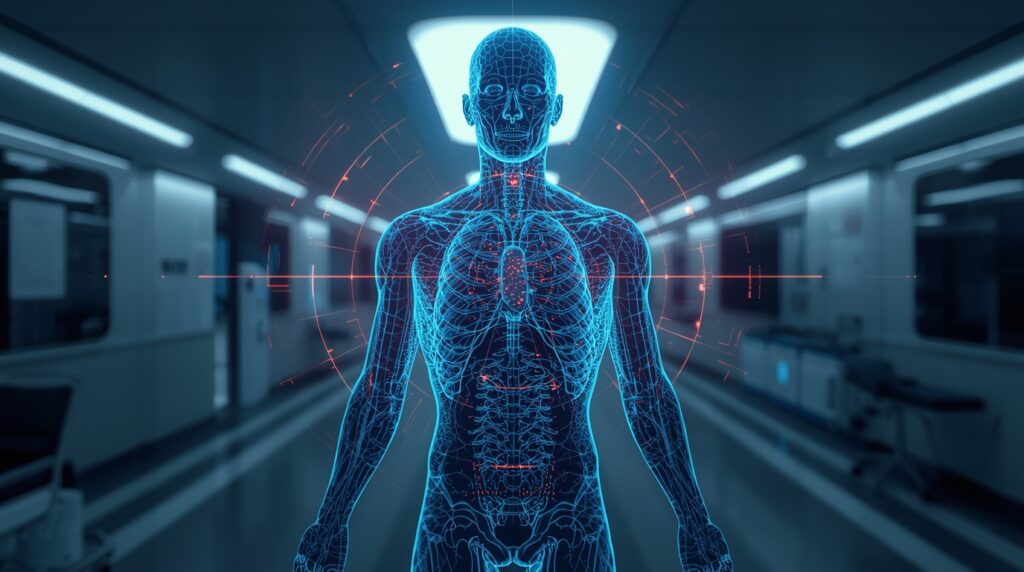AI in Healthcare: The Art of Seeing Before It’s Too Late
By 2025, artificial intelligence has quietly taken on the role doctors always dreamed of but rarely admitted: the clairvoyant. It doesn’t cure disease, at least not yet. What it does is far more unsettling—it notices. It sees the microscopic shadow on a scan, the genetic whisper in your DNA, the irregular rhythm your smartwatch catches at 3 a.m. In short, AI has become the world’s most tireless diagnostician.
Why Early Detection Is Everything
Detecting disease early is like catching a match before it becomes a wildfire. Cancer survival rates can soar by 70%. Prediabetes can be reversed with diet before it devours organs. Alzheimer’s progression can be slowed, buying families precious years.
And yet, humans are fallible. We blink, we overlook, we miss the faint patterns hidden in data. Machines, with their tireless gaze and unflinching memory, don’t. That’s why AI is rewriting preventive medicine: not by replacing doctors, but by out-seeing them.
Four Frontiers of the AI Revolution
1. Imaging: Machines That Read Shadows
Radiologists used to spend hours peering at films, hoping not to miss a faint spot that could mean life or death. AI now scans mammograms, CTs, and MRIs in minutes—matching, sometimes surpassing, human experts.
- Breast cancer: Algorithms catch tumors that evade the human eye.
- Lung disease: AI flags silent cancers before symptoms ever appear.
- Neurology: Microchanges in the brain, imperceptible to specialists, now light up for machines.
Ironically, what took decades of training for humans, AI now does in seconds—with the stamina of a machine that never tires.
2. Genomics: Reading Our Biological Code
The human genome was once a labyrinth; now it’s an open book for algorithms. AI parses billions of letters of DNA, tracing predispositions to cancer, heart disease, and autoimmune disorders.
A genetic variant that once meant years of uncertainty now points to tailored preventive care plans. Personalized medicine is no longer a slogan; it’s a spreadsheet of probabilities with your name on it.
3. Wearables: Doctors on Your Wrist
The humble smartwatch has become an oracle of the bloodstream. Heart rhythms, glucose levels, oxygen saturation—AI stitches these into real-time warnings.
- A cardiac arrest predicted hours before it strikes.
- Diabetic spikes tamed by instant alerts.
- Respiratory infections caught at their first breath.
The doctor’s office, in other words, has migrated to your wrist.
4. Public Health: Predicting the Next Pandemic
AI isn’t just diagnosing individuals—it’s scanning societies. Algorithms already flag flu outbreaks by parsing search queries and wearable data. By combining socioeconomic and environmental data, they identify neighborhoods most at risk for chronic disease.
It’s epidemiology on steroids: governments can now see tomorrow’s health crises today.
NEAR Protocol and iDEGEN: Top AI-Powered Cryptos to Watch in 2025 – CrypTonaryx

The Thorns Among the Roses
Every major technological shift comes with contradictions and AI in healthcare is no different because while it promises precision and accessibility it also raises concerns about data privacy as medical records become valuable targets for hackers and about bias since algorithms can overlook illnesses affecting underrepresented groups. Trust becomes another challenge as patients must rely on machine judgment while doctors try to stay central in decisions and equity remains an issue when advanced AI tools appear mainly in wealthy hospitals which could deepen inequality instead of reducing it.
Breakthroughs in Action
Despite these challenges AI is already transforming real hospitals with AI-assisted mammograms in the UK reducing false negatives and unnecessary biopsies ECG-reading algorithms in the US predicting sudden cardiac arrest risk years earlier and DeepMind’s retinal scan system identifying dozens of eye diseases with specialist-level accuracy proving that these advances are happening now not in the distant future.
Tomorrow’s Healthcare
The next phase of medicine is forming as multi-modal AI combines scans genes and wearables to create more complete diagnoses while digital health twins simulate patient outcomes before symptoms appear and insurance systems integrate AI guidance into daily habits shifting healthcare from reactive treatment to preventative personalized care.
Conclusion: From Reacting to Anticipating
AI’s gift to healthcare is not omnipotence but foresight. It turns the system from a battlefield triage unit into a preventive shield. Millions of lives could be spared, billions in costs saved, and the cruel lottery of late diagnosis reduced.
The challenge is not whether AI can see—clearly, it can—but whether societies will share that vision fairly, protect the data it feeds on, and ensure the human remains at the heart of the machine.
If those conditions are met, AI may prove to be the greatest ally medicine has ever had: not the healer itself, but the vigilant sentinel who sees illness before it ever announces its arrival.
